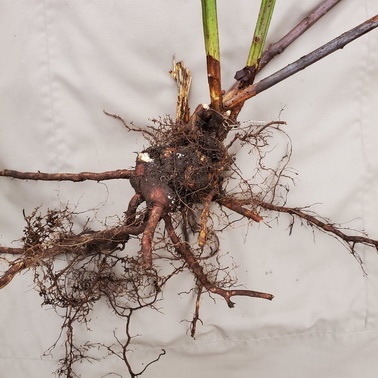This blog is aimed at the person who doesn’t have experience removing Himalayan Blackberry and may be intimidated by the prospect of doing it. My message is basically this – it’s not as hard as it looks, and you don’t have to get scratched up if you take your time.
I always wear thick gloves and a heavy jacket for protection when removing Himalayan Blackberry. I spend most of the time methodically clipping back vine stems until I have clear access to the base of the plant. Next, I take a strong digging shovel and use it to pry out the plant. Usually, I do not have to dig it out entirely, just use the shovel to loosen the taproot. Here’s a description of what I call “pry and pop, wiggle and pull.”
Pry and Pop, Wiggle and Pull
With one foot I push the shovel into the ground, about 4” back of the base of the plant, to the full blade’s depth if possible. Keeping my foot on the shovel to maintain pressure, I lever backwards on the handle to loosen the soil and pry up the taproot. I pull back until I hear and/or feel a “pop” as the taproot pulls loose from the ground. If I don’t seem to engage the taproot on my first try, I move around the base and try from another angle. Once the root has popped, I tilt the shovel back up to an upright position and pull it out of the ground with minimal disruption to the surface of the soil. I reach down with one hand into the soil and get a good grip around the taproot. I wiggle and pull, vigorously at times, to work the plant out of the ground, and shake the dirt off the roots. At this point I may discover lateral roots that I try to follow and remove. I also pay attention to the fact that one of the vine stems may have rooted in the ground at its far end. I try to dispose of Himalayan Blackberry plants on compost heaps, especially the stems and bases with roots attached.
Get the Roots
As with all manual removal of invasive plants, the key is getting the roots out. This takes patience but saves time in the long run. I’ve tried just pulling the plants without the shovel, but when some of the taproot is left in the ground, the plant usually regrows.
Take Heart
Older plants often have an enlarged bulb on the taproot, sometimes referred to as the “heart,” and I’ve heard that “if you get the heart, it won’t grow back.” So, take heart — that patch of Himalayan Blackberry on the edge of your backyard forest may not be as difficult to remove as you might have expected.
